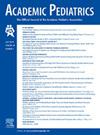Disparities in Caregiver-Reported Knowledge, Attitudes, Behaviors, and Clinical Guidance Regarding Primary Prevention of Peanut Allergy
IF 2.8
3区 医学
Q1 PEDIATRICS
引用次数: 0
Abstract
Objective
Significant differences have been observed in the prevalence of peanut allergy across different US racial and ethnic groups. We aimed to characterize current patterns of infant peanut introduction across racial, ethnic, and socioeconomic strata, and their clinical, behavioral, and attitudinal correlates.
Methods
Surveys assessing parental knowledge, attitudes, and infant feeding behavior were administered to a US population-based sample of 3062 parents/caregivers of children aged 7 to 42 months. Complex survey-weighted test statistics estimated differences across relevant racial/ethnic, household income, and caregiver educational attainment strata.
Results
Cumulative rates of peanut introduction in the first 11 months of age were significantly higher among White, non-Hispanic caregivers (F = 7.7; P<.001), caregivers with higher annual household incomes (F = 5.6; P<.001), and caregivers reporting higher educational attainment (F = 2.5; P = .002). Similar racial, ethnic, and socioeconomic differences emerged regarding perceived safety of peanut introduction during the first year, as well as the perceived effectiveness of early dietary introduction for peanut allergy prevention. Caregivers reporting lower household incomes and educational attainment were less likely to think peanut introduction during the first year was safe or effective in peanut allergy prevention than those reporting higher socioeconomic status. Similarly, caregivers of non-Hispanic Black children, those with lower incomes, and those with lower educational attainment were less likely to report receiving timely guidance from their child’s primary care provider regarding peanut allergy prevention.
Conclusions
Differences in the timing of peanut introduction may contribute to observed racial, ethnic, and socioeconomic disparities in peanut allergy prevalence. Equitable food allergy prevention guidance from providers could address these disparities.
护理人员报告的关于花生过敏一级预防的知识、态度、行为和临床指导的差异
目的:花生过敏的患病率在美国不同种族和族裔群体中存在显著差异。我们的目的是描述目前婴儿花生引入的不同种族、民族和社会经济阶层的模式,以及他们的临床、行为和态度的相关性。方法:对美国人口为基础的3062名7-42个月儿童的父母/照顾者进行调查,评估父母的知识、态度和婴儿喂养行为。复杂的调查加权测试统计估计了相关种族/民族、家庭收入和照顾者教育程度阶层之间的差异。结果:前11个月花生引入累积率在白人、非西班牙裔看护者中显著较高(F=7.7;结论:花生引入时间的差异可能导致花生过敏患病率的种族、民族和社会经济差异。提供公平的FA预防指导可以解决这些差异。
本文章由计算机程序翻译,如有差异,请以英文原文为准。
求助全文
约1分钟内获得全文
求助全文
来源期刊

Academic Pediatrics
PEDIATRICS-
CiteScore
4.60
自引率
12.90%
发文量
300
审稿时长
60 days
期刊介绍:
Academic Pediatrics, the official journal of the Academic Pediatric Association, is a peer-reviewed publication whose purpose is to strengthen the research and educational base of academic general pediatrics. The journal provides leadership in pediatric education, research, patient care and advocacy. Content areas include pediatric education, emergency medicine, injury, abuse, behavioral pediatrics, holistic medicine, child health services and health policy,and the environment. The journal provides an active forum for the presentation of pediatric educational research in diverse settings, involving medical students, residents, fellows, and practicing professionals. The journal also emphasizes important research relating to the quality of child health care, health care policy, and the organization of child health services. It also includes systematic reviews of primary care interventions and important methodologic papers to aid research in child health and education.
 求助内容:
求助内容: 应助结果提醒方式:
应助结果提醒方式:


